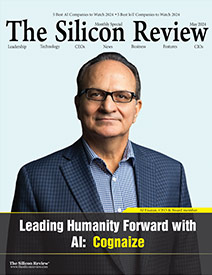HeartFlow – Transforming the Way Cardiovascular Disease is Diagnosed and Treated
The Silicon Review
![]()
Healthcare across the world has witnessed transition to new business models in order to improve patient care and operating efficiencies. Some of the recent advancements include Artificial intelligence (AI), advanced algorithms, and predictive analytics facilitating early detection and treatment of critically ill patients, in improving outcomes and providing value-based care. Then comes remote connected care that allows electrocardiogram (ECG) diagnosis using cloud technology and bluetooth-enabled cardiac devices which measure the parameters and transmit them back to healthcare providers without physically visiting the clinic.
HeartFlow is a medical technology company which provides revolutionary diagnosis and treatment for cardiovascular diseases. With HeartFlow Analysis, a non-invasive personalized cardiac test, physicians are able to make better care decisions for their patients with suspected coronary artery disease--the number one killer of men and women worldwide. HeartFlow is backed by decades of scientific research and development and leverages the latest advancements in technology to help set a new standard of care for diagnosing cardiovascular care worldwide. Cleared for use in the United States, Canada, Europe and Japan and with offices in Redwood City, Austin, London and Japan, HeartFlow’s footprint is growing rapidly. HeartFlow has received more than $240 million dollars in funding in a recent Series E financing round, is pre-IPO and leverages the latest technology including deep learning and computational fluid dynamics.
Transforming Coronary Artery Disease Detection
HeartFlow FFRCT Analysis: At the intersection of health and technology, HeartFlow leverages advanced technology and applies it to healthcare. With the HeartFlow FFRCT Analysis, HeartFlow is driving towards a new standard of care for the diagnosis and management of coronary artery disease – the number one killer worldwide.
To date, more than 100,000 patients worldwide have received a HeartFlow Analysis. The momentum is growing with partners in major healthcare systems and local communities bringing HeartFlow to their patients. Now you can explore multiple clinical scenarios vessel-by-vessel using virtual modeling. Review and modify treatment plans with colleagues pre-procedurally and visualize your treatment path at any time, from anywhere.
HeartFlow Planner: It is the only interactive tool that lets you model multiple treatment strategies in real time before you ever enter the cath lab. The modeled stenosis marker, indicated by a white ring, identifies an area of >30% narrowing in the anatomic model. FFRCT pins provide specific values and can be viewed at any point along the vessel. When selected, a stenosis marker will show a dotted line that indicates the area of the model affected by the narrowing. The range tool’s end dots can be used to adjust the desired length of the region to modify. Once the range tool is adjusted, you can open the lumen to display the impact of your selected strategy on the modeled vessel. Then revert the changes to explore other scenarios.
Coronary CTA: The path to diagnosing coronary artery disease (CAD) hasn’t always been clear or reliable. The CT-Flow™ pathway enables physicians to more accurately diagnose patients with suspected CAD by combining two powerful, non-invasive technologies — coronary CTA (CCTA) and the HeartFlow Analysis. The CT-Flow pathway begins with a CCTA. If the physician sees disease, the CCTA images are sent to HeartFlow, where AI algorithms, computational fluid dynamics and trained analysts create the HeartFlow Analysis. This personalized, color-coded 3-D model of a patient’s coronary arteries provides functional information about each blockage. The CT-Flow pathway provides the highest diagnostic performance available from a non-invasive test to help identify functional disease. This pathway leads to targeted treatment plans and a more streamlined patient experience. Physicians can use the CT-Flow pathway for any clinically stable symptomatic patient with CAD. The pathway requires access to a standard CT scanner and an institution that offers the HeartFlow Analysis. CT-Flow offers a streamlined workflow that reduces unnecessary invasive testing and radiation exposure, and provides more accurate information about their condition compared to other non-invasive cardiac tests. The highly visual, color-coded model resonates well with patients and can help increase adherence to treatment plans.
The Dynamic Leader at the Helm of HeartFlow
John Farquhar is the President, Chief Executive Officer, and Member of the Board of Directors of HeartFlow. He brings more than 20 years of experience providing strategic oversight to deliver operational excellence and outstanding performance. Most recently, John served as Vice President and General Manager of the Aortic business at Medtronic. He also served in key leadership roles for Medtronic's Cardiovascular and Diabetes Groups, including Vice President of the Americas region for the insulin Pump and Continuous Glucose Monitoring business unit and Vice President for Asia Pacific.
Mr. Farquhar earned his BA from Duke University and his MBA from Northwestern's Kellogg School of Management.









